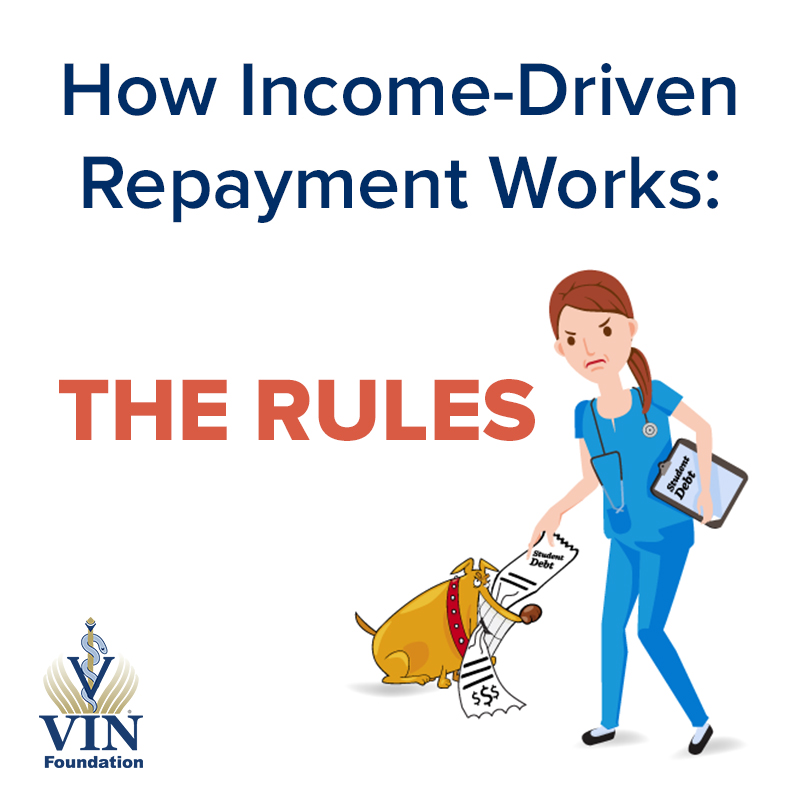“I was looking at the income-driven repayment plans, and the Pay As You Earn (PAYE) option seems like it will cost me the least amount of money. However, everything I read online says that the income-driven repayment plans cost you more money because although they lower your monthly payment, you ultimately pay more interest in the long run. I was wondering if you could break this down for me? I don’t understand how it will cost me the least amount of money if I never hit the principal balance and pay more interest?”
This question, asked by a 2019 veterinary graduate who attended the recent new graduate webinar we presented on student debt, is one of the most confounding aspects of income-driven repayment (IDR). Unfortunately, this confusion often prevents veterinarians from accepting the student loan repayment relief and other benefits provided by an income-driven repayment strategy.
Let’s break down this common question as requested:
Your payment under an IDR plan like PAYE is based on your taxable income and family size. Mathematically, your payment under PAYE is 10% of your discretionary income. Discretionary income is a government measure with the following formula:
DISCRETIONARY INCOME = TAXABLE INCOME – 150% FEDERAL POVERTY GUIDELINES FOR YOUR FAMILY SIZE
As long as your payment, under PAYE, calculated from your discretionary income, is less than your payment due under a standard 10-year plan (also known as partial financial hardship), you are eligible for the reduced PAYE monthly payment.
The math is straightforward, however, this is the part that causes concern: Oftentimes, particularly when the amount you owe exceeds your annual income, your IDR payment will be less than the interest that accrues each month.
WHEN YOUR PAYMENT IS LESS THAN YOUR MONTHLY INTEREST, YOUR STUDENT LOAN BALANCE WILL GROW.
Using income-driven repayment there is a set amount of time you pay your student loans generally between 20 and 25 years depending on the plan and when you started borrowing. Once you reach that maximum repayment period, any remaining balance is forgiven and treated as taxable income.
Although it might sound scary to face this tax bill, understanding how this affects your total student loan repayment costs is crucial to maximizing the benefits of an IDR strategy.
Projecting your total repayment costs using IDR requires you to make estimates about your future income, marital status, family size, and income tax rates — no easy feat to calculate on your own.
However, the right tools, we can help you compare your options and find strategies that best fit your circumstances. The VIN Foundation Student Loan Repayment Simulator helps you input your individual situation to see how your loan repayment costs are affected — and colleagues at the VIN Foundation are ready and willing to help you understand the output should you need the help.
Now that we’ve covered the basics, we can answer the question about IDR costing the least even when you are accumulating the most interest during your repayment period.
A lot of the confusion comes from the way the question is asked. Yes, it is true that when your student debt exceeds your income, especially for the first several years in repayment, it is quite possible that paying the minimum required under a plan like PAYE and planning for the forgiveness will result in the lowest total repayment cost.
During repayment, your balance will likely grow due to unpaid interest accrual. It is quite possible that you will never even hit the principal balance. And while you accrue more interest, it doesn’t necessarily mean that you pay more interest. That would only be true if you paid the balance to zero prior to reaching forgiveness.
However, if/when you reach forgiveness, your remaining balance will be canceled and treated as taxable income. Even in the worst-case scenario, under current tax laws, your remaining balance would be subject to a 37% federal income tax rate (plus any state tax if you live in a state that assesses income tax). That can result in a significant discount in the remaining balance — a 63% discount (or more).
The tax on forgiveness which usually scares people away from income-driven repayment is what ultimately helps you pay less in total on your student loans. The trick is knowing how much will be forgiven and preparing for that anticipated tax.
Because math injected into articles usually makes peoples eyes roll into the back of their heads, I will include the breakdown of how this works financially in a separate post that you can investigate on your own using the debt and income specifics for the person who originally posted the question. You can run through her case and see if the concepts we cover apply to your situation or result in additional questions for your repayment strategy.
If so, please do not hesitate to reach out for assistance — we’re here to help!

Tony Bartels, DVM, MBA
Dr. Tony Bartels graduated in 2012 from the Colorado State University combined MBA/DVM program and is an employee of the Veterinary Information Network (VIN) and a VIN Foundation Board member. He and his wife have more than $400,000 in veterinary-school debt that they manage using federal income-driven repayment plans. By necessity (and now obsession), his professional activities include researching and speaking on veterinary-student debt, providing guidance to colleagues on loan-repayment strategies and contributing to VIN Foundation initiatives.

